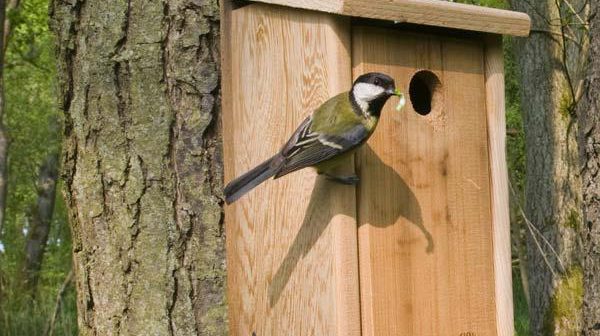This year’s inspection of nest boxes at Sharphill Wood is now complete following a 9th visit today just to check the final box. Thanks to Chrissie, Hilary, Jan, Simon, Tim and Zdena, who assisted me, and apologies to any of the other volunteers who didn’t get a chance.
It was a very strange year, with many nests already more or less built by the first visit in mid-April, but many of these failing to progress much during the coming weeks of cold and wet weather. In the end, only 7 boxes (of the 28 inspected) reached the egg stage, and 4 of these ended in failure. Of the successful boxes, two were used by Great Tit (fledging 3 and 4 young respectively) and one was used by Blue Tit (fledging 4 young). In one of the failed boxes the eggs were abandoned, and in another the young were found dead. A third box suffered predation by a woodpecker (presumably a Great Spotted Woodpecker) through the base of the box, soon after the Blue Tit chicks had hatched. The fourth nest was in one of our boxes designed for Treecreeper, but a Blue Tit managed to get in and build a nest. Unfortunately we think this too suffered woodpecker predation, because the entrance, which was not protected by metal, had been enlarged. All detailed observations have been entered into the BTO Nest Record Scheme database.
In summary, this was another difficult year for our Blue Tits and Great Tits, presumably not helped by the weather and its impact on caterpillar supplies. Last year we were unable to carry out inspections during lock-down, but hopefully that would have been a far better year. But at least some birds did fledge this year and will not have quite so much competition from other young while trying to feed up and survive the winter. It was certainly nice to hear a family of Blue Tits chattering away this morning while on our way to check the final box.
John Elwell (work party coordinator)
POSTSCRIPT (18/12/21):
The British Trust for Ornithology (BTO) has just published its preliminary report on the 2021 breeding season. This report is based on data gathered through the Nest Record Scheme (NRS, the scheme to which our nest box data is submitted) and CES (one of the ringing projects).
An extract from the report is as follows:
“2021 proved to be a disastrous breeding season, with 18 of the 24 species recorded through CES displaying significant declines in productivity compared to the five-year mean (Table 1) and none exhibiting significant increases. Six species recorded their lowest breeding success since CES monitoring began; Willow Warbler, Treecreeper, Wren, Blackbird, Dunnock and Willow Tit. NRS results indicated that four species produced lower than average numbers of fledglings per breeding attempt (FPBA): Blackcap, Blue Tit, Great Tit and Tree Sparrow. For Blackcap and Great Tit, this represents their lowest breeding success since NRS monitoring figures were first produced in the mid-1960s; Great Tit also recorded its lowest ever clutch size in 2021. The cold, wet spring and early summer is the most likely cause of poor offspring production, preventing fledging or increasing mortality of fledglings shortly after they had left the nest.”
This correlates with the very poor breeding success seen in our nest boxes.
The full report is available here: https://www.bto.org/our-science/projects/bird-ringing-scheme/ringing-surveys/constant-effort-sites/ces-results?dm_i=2I9K,1TK64,91DO78,6B12T,1
Let’s hope for better weather next spring and a more successful breeding season.
John



